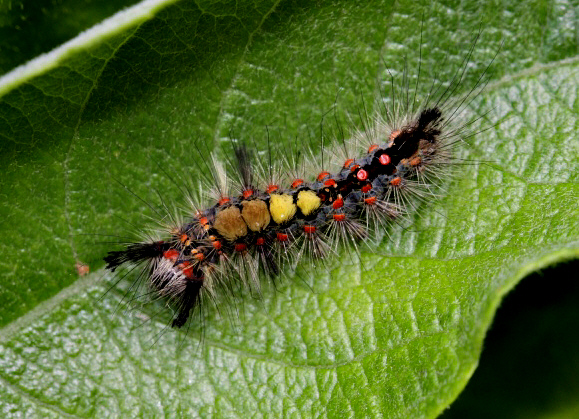
Introduction
There are about 2700 species worldwide in the subfamily Lymantriinae, the highest concentrations of species being found in South America and the Afrotropical region. Madagascar alone accounts for no less than 258 species. There are 32 species in Europe, of which 11 have been recorded from the UK. Two of these are now extinct in Britain, the Reed Tussock Laelia coenosa and the Gypsy moth Lymantria dispar, although the latter is slowly becoming re-established following introductions and immigrations from continental Europe where it is still a common species.
Moths in the Lymantriinae are generally brown, greyish or white in colour, and most species only bear weak patterns, typically in the form of dark suffused greyish lines. Most species are nocturnal, although there are several diurnal genera including Orgyia.
The genus Orgyia comprises of between 65-70 species. They are represented in all temperate and tropical regions of the world. There are 13 species in North America and 10 in western Europe. All Orgyia species have predominantly brown or greyish-brown males. The females are wingless, or have very reduced wings, so cannot fly.
Their bodies are fat due to being heavily laden with eggs. Overall they have a quite spidery appearance. Their inability to fly means that the maintenance of genetic diversity is reliant on the ingress of flying males, aided by the fact that a single female may mate with several different males. Colonisation and expansion of range however occurs only as a result of continuing short-distance dispersal by the caterpillars, yet amazingly some species such as antiqua are extremely widespread, and inhabit a vast number of different habitats.
Orgyia antiqua is by far the commonest and most widespread member of the genus, being found throughout most temperate regions of the northern hemisphere.
Habitats
This species is ubiquitous in forests, parks, farmland, gardens, scrubby grasslands and heaths, and can even be found in city centres.
Lifecycle
The Vapourer forms its pupa within a silky cocoon attached to tree trunks, fence posts, brick walls or virtually any other rough textured vertical surface. The wingless females emerge and spend their entire adult lives sitting on their cocoons. They disseminate potent pheromones to attract males in from distances of 2km or more away. It is these pheromones or ‘vapours’ that give the moth its English common name.
After mating the females lay all their eggs in a single flat batch of about 200, on their cocoon. Upon hatching the tiny larvae eat the upper part of their eggshells, and then rapidly disperse in search of foodplants. They feed on a wide variety of trees, bushes and woody plants.
The caterpillars are blackish, and have tufts of stiff setae emerging from red or orange tubercules on the back and sides. The first thoracic segment bears a pair of long black forward-pointing tufts, and their is a group of 4 dense tussocks of cream or buff coloured setae arising vertically like little shaving brushes from the first 4 abdominal segments. Female caterpillars grow to about twice the size of males.
Adult
Adult males fly on sunny days between late July and mid-October. They have a rapid erratic flight, twisting and turning as if in a demented state, and soaring high above trees. In Leicester the moths have even been observed from the 13th floor of a city centre building. The apparently crazy flight pattern is quite deliberate – the rapid and random changes of direction make it much easier for the moths ‘scent radar’ to track and home in on the pheromone trail of the females.
